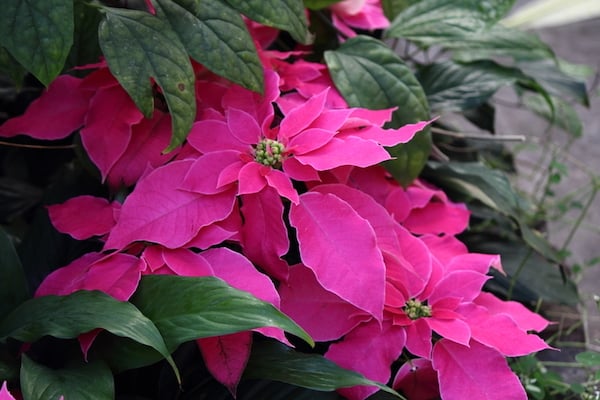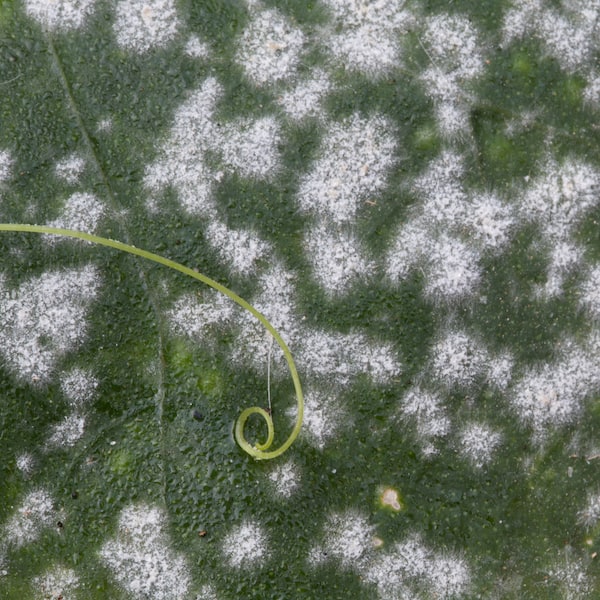
Poinsettia Pests and Diseases – Identifying & Controlling them
Our site is reader supported, this means we may earn a small commission from Amazon and other affiliates when you buy through links on our site.
There aren’t any exclusive poinsettia pests and diseases to watch out for and on the most part, if grown indoors, there usually pest and disease free. These plants are, however, sometimes susceptible to the usual range of pests and diseases that plague any houseplant. As such, dealing with problems such as grey mould, scale insects, and thrips is quite straightforward. And none of these is fatal to your poinsettia. If you are having problems with your poinsettia, below are some of the potential pests and diseases that could be causing it.
Poinsettia pests
Scale insects
What scale insects
With over 25 varieties around, chances are that the infestation on your poinsettia is some kind of scale insect. Most scale insects are around 6mm long or smaller (except for scale insects on wisteria which are huge by comparison). The problem is they have a waxy shell which gives them some protection from spray treatments.
Scale insects are among the many insects that suck the sap from the plant’s leaves, feeding also on the stems. This weakens the plant, making it less able to generate energy for further growth and for maintaining existing foliage. A heavy infestation can cause the plant to die back although this is quite rare.
Noticing scale insects
Unless there’s a heavy infestation of scale insects clumping in a mass, they’re difficult to see. Check the underside of the leaves and along the stems.
What is more obvious to the naked eye, however, is the honeydew substance they excrete. This is a clear, sweet, sticky substance that you find on leaves. Look first on the leaves that are yellow and wilting. This substance doesn’t actually harm the leaves itself, but it does attract ants that do so and is a breeding ground for harmful black sooty mould.
Controlling scale insects on poinsettias
You can get away with a few scale insects on your plant. They won’t cause too much damage. But any more than that is a problem. The first step in their control is to pick them off one by one if you see them. For a group of scale insects, try a spray of natural oils such as pyrethrum or even a pesticide as a last resort but being indoors, look for house plant pesticide spray.
Adult scale insects are hard to kill, so it’s best to go after the young nymphs. These appear around mid-summer so pay special attention to your poinsettia then. This assumes you have grown it on after Christmas.
Thrips
What thrips are
Thrips are very small insects, about 0.1cm long. Chances are that you won’t see them as they’re extremely small. This is a time when it’s best to have a magnifying lens with you when you examine the plant. They’re black, greenish brown or tan and the adults have feathery wings as shown in the picture above.
Thrips are another insect that feeds by sucking the sap from a plant’s leaves, especially the underside, and the flowers. As well as harming your plant’s leaves, thrips also spread some viruses, so they’re doubly dangerous.
Spotting thrips
As I’ve said, thrips are extremely small so it’s the damage they do that you notice. Look for silver-coloured discolouration on the leaves’ surfaces, particularly underneath. This sometimes looks like silver flecks. It’s easy to confuse this damage with that done by scale insects, but you can see the scale insects and not the thrips.
Controlling thrips
Put up a blue sticky trap next to your poinsettia. Thrips appear to be attracted to this, but not yellow sticky traps; not sure why. They head towards the traps and become stuck on them.
You can spray the poinsettia with a natural oil, such as neem diluted with water, or a solution of insecticidal soap and water. Horticultural oil is a little stronger for more severe infestations.
As a last resort, you can use a pesticide but being a mainly indoor plant, I try to avoid this. This kills all insects it encounters, good and bad.
Bear in mind that by the time you’ve noticed the damage done by the thrips, they may have moved off to another plant. If this is the case, I’d remove damaged leaves and see how it gets on.
Mealybugs
What mealybugs are
Yet another sap-sucking insect that commonly infests indoor plants is the mealybug. They love the warm conditions that you place your poinsettia in. By sucking the sap from the leaves, the plant becomes weakened. It’s unable to maintain the existing foliage, let alone develop any new shoots and buds.
Finding mealybugs
While mealy bugs aren’t microscopically small, it’s still difficult to find them. This is because they live in the parts of a poinsettia that’s out of sight. They live together in groups in the leaf sheafs and even on the plant roots.
But mealy bugs are one of the insects that leave behind honeydew. That’s the clear and sticky substance that they excrete onto the leaf surfaces. This attracts ants and also forms a hospitable growing surface of black sooty mould. Either of these problems could indicate the presence of mealybugs.
Controlling mealybugs
Don’t be fooled into thinking that a few mealybugs are no big deal. They quickly build a dense population that swarm over the plant. Quickly remove the bits of the poinsettia that have the bugs on them, and place the plant into isolation from any other plants. Watch to see if you’ve got all the mealybugs from it.
Mealybugs don’t travel far, so the infestation on the poinsettia has probably come from a nearby plant. Check all your plants carefully and treat them if you do find mealybugs on them.
If you do have a heavy infestation of mealy bugs, there’s nothing you can do about it except to get rid of the whole plant. Thoroughly clean down the area in which the poinsettia sat and check all nearby plants carefully.
Poinsettia diseases
Grey mould
What grey mould is
Grey mould is a fungal disease caused by overwatering the plant. The general rule is to water the poinsettia only when the top surface of the soil is dry. Grey mould usually enters the plant through a lesion or wound and affects plants under stress (e.g. just after pruning). It affects most ornamental plants.
Noticing grey mould
If the poinsettia is in a humid environment, you may notice fuzzy grey-brown mould on buds, leaves, or flowers that are all decaying. If the surrounding environment is dry, the disease may be in just a few spots but it can spread rapidly. The buds and flowers shrivel and die. The infected parts often have small seed-like black structures on them.
Overwatering the plant and leaving it to stand in excess water creates the moist environment that this mould prefers.
Controlling grey mould
Stick to this watering rule of thumb – water when the top of the soil/compost is dry. If you’re keeping your poinsettia from one winter to the next and adjusting the watering schedule as per the instructions in my article, How to get poinsettias to turn red again, keep a close eye on the moistness of the soil.
Remove any dead or dying parts of the plant immediately, the leaves, buds and flowers. Don’t leave any dead plant material lying around. Reduce the humidity around the plant or move it to a drier spot.
There are no fungicides approved for use against grey mould.
Powdery mildew
What powdery mildew is
Powdery mildew is a common disease for which the best treatment is prevention. It likes warm and wet environments with poor air circulation. Powdery mildew changes form for different types of plant but most of the different types look the same.
Recognising powdery mildew
Powdery mildew is easy to identify. It’s patches of white powder on the poinsettia’s leaves. but it also appears on the underside of the leaves, on the stems, flowers and buds – pretty much everywhere. The patches don’t completely cover the leaf at the start, but they are close together. Eventually, the complete leaf is coated, and even then, the entire plant submits to the white powder.
Controlling powdery mildew
This disease isn’t usually fatal to your poinsettia though it does take away from its visual attractiveness. It’s very hard to get rid of this disease once it’s moved onto your plant, so prevention is the best solution.
Spray the poinsettia with a copper or sulphur fungicide to prevent the problem. This reduces but doesn’t eliminate powdery mildew outbreaks.
Don’t overwater the plant. Water it only when the top of the soil becomes dry. And make sure that the excess water drains away through the pot, leaves just a moist soil environment behind. If the soil becomes waterlogged, lighten it up by adding some horticultural grit.
As for the diseased part of the plant, cut it away carefully, being sure not to spread the disease spores. If most of the plant is infected, cut it back to start with healthy growth. You may be able to save a few branches with flowers on.
Root rot caused by overwatering
What root rot is
Root rot is another fungal disease. While root rot usually affects outdoors plants and shrubs, it can also harm indoor plants. It’s a consequence of overwatering the poinsettia and letting the plant then sit in waterlogged soil.
Signs of root rot
As its name suggests, root rot starts in the root of the plant. So you don’t see it at first. The roots start to decay and rot, and the rotting moves its way up the plant, becoming stem rot. Everything becomes squishy and soft.
Leaves start wilting and become yellow, brown or red before dropping off. You can’t see to stop the plant from wilting no matter how much water you give it. Which in fact is making the problem worse.
Controlling root rot
First of all, there’s prevention. Make sure the soil in the pot drains easily and thoroughly. Add horticultural grit or perlite is necessary to lighten up the soil. Only water your plant when the top of the soil is dry. And water at the base of the plant, not down over the leaves, as this encourages a moist environment that just invited diseases in.
There are no chemical treatments for root rot. By the time you notice the above-ground symptoms, most of the roots are rotting. The only thing to do is to destroy the entire plant.
Sooty black mould
What sooty black mould is
Sooty black mould is a fungal disease that loves to grow on honeydew on leaves. Honeydew is a clear, sweet and sticky substance excreted by some sap-sucking insects (see Pests section above). This fungal mould doesn’t attack the leaves itself but it does leave them looking quite unsightly.
Signs of sooty black mould
It’s hard to miss this mould. It looks like a black powder that’s in splotches on the top side of the poinsettia’s leaves. It stops the sunlight getting to the leaves and so photosynthesis is reduces. This reduces the amount of energy available to the plant and weakens it considerably.
Controlling sooty black mould
Sooty black mould is fairly easy to remove. Just wash it away with a mild soap and water solution. The leaf appears from underneath the black powder.
But that’s just treating the symptom. You still have a problem with the sap-sucking insect that created the honeydew that attracted the mould. Read the Pests section of this article to track those down and control them.




